
15.03.2021
We’re witnessing the biggest renaissance in the 3D design space in 40 years. Here’s a look at the past and the future of 3D design creation platforms.
The excitement about Apple ARKit and advancement in technologies like AR and VR raised an important subject: 3D content. Like any other publishing platforms, AR and VR are worthless without great content. Having books for the ‘Amazon Kindle’ or signed artists and music labels to any music streaming service out there now are important more than ever for these platforms. It seems major companies like Google, Facebook and Microsoft took a note and it’s a matter of time until we will see Apple and Amazon follow.
The History of 3D Design Software
3D content is amazing, but at the same time, very hard to create. It all started in 1972, by Fred Parke and Ed Catmull, who will later be one of the founders of Pixar. 3D modeling and animation, back then, was still something you had to program and not design.
Three years after ‘Industrial Light and Magic’ (ILM) was founded (1975) and soon after in the 1980’s we could see a flourish of commercial products, created by companies like Autodesk, Omnibus Computer Graphics, Pro/ENGINEER and more.
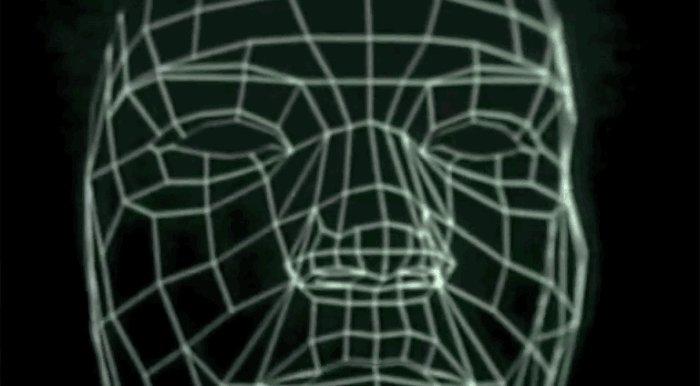
First face and hand 3D animation by Ed Catmull and Fred Parke
First Face and Hand 3D animation by Ed Catmull and Fred Parke (YouTube)
In the 1990’s we saw a progression in the shape of affordable and more user-friendly software. Software from different fields, like 3DS-Max for animation (1990), SolidWorks for solid modeling (1995), and SketchUp for Architecture design (1999) were created and allowed more people to join the 3D design space, each in their way and field.
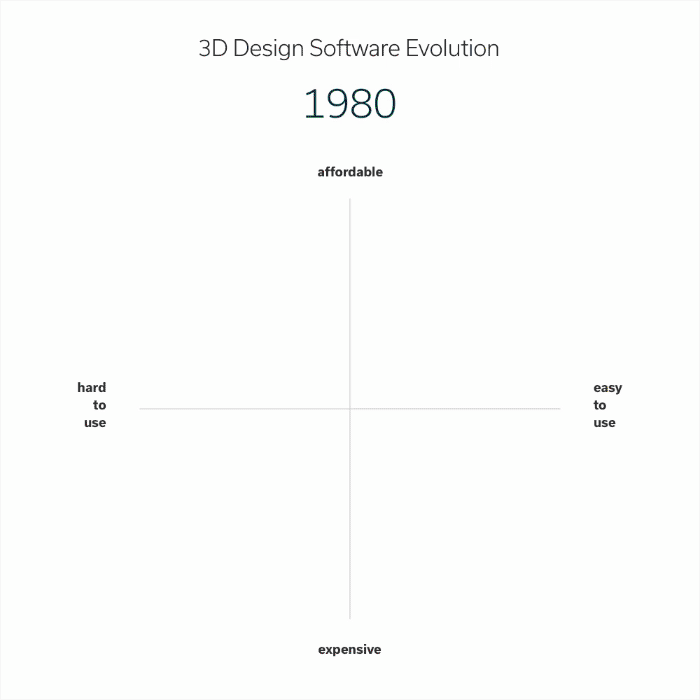
3D design software market evolution - 1980-2020
3D Design Software Market Evolution — 1980–now
These software were focused on professional designers and programmers since the learning curve was very steep. Although many tried to find the right user interface for a 3D design software, it was always the biggest challenge, and some of that challenge remains with us even now.
And Then Came the iPhone…
Since the launch of the iPhone in 2007, our lives changed in so many ways, especially for designers. You can read more about it in my previous post ’10 years for the iPhone — What’s Next for Designers?’.
How has mobile changed the way we do 3D design? It pushed developers to rethink the user interface of 3D design apps to make it easier for everyone to participate in the design process: more ideas and inspiration, more collaborators — better design. While we’re still using software that was built in the 1980’s and 1990’s, we see two trends that are happening right now:
Consumerization of Enterprise features
The most famous example of that is ‘Instagram’ which enabled anyone to drastically and easily enhance their photos by taking the most desired features from Photoshop and making them accessible to anyone simply by applying magical filters.
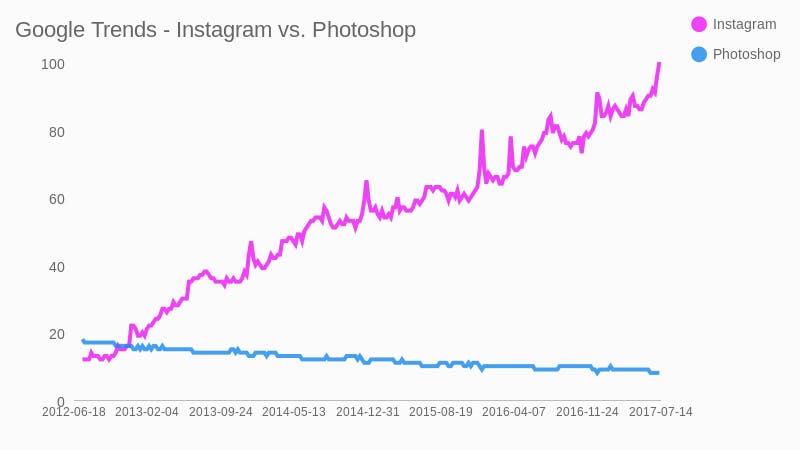
Google Trends - Photoshop vs. Instagram
The transition of fully-featured apps (‘Super Apps’) to mobile
Since the launch of the iPad, more and more kids are have shown a preference for using mobile devices while abandoning the PC. With that change, they also familiarize themselves with different types of apps — from utilities and games to ‘Super Apps’.
These apps allow you to create content professionally. ‘ProCreate’ and ‘Sketchbook’ were the first apps to fully allow 2D painting on the iPad. In 2015, we were fortunate enough to set the bar for 3D design apps with the release of uMake along with the launch of the Apple iPad Pro, to allow anyone to create in 3D. It was a good start, and we’re looking forward to pushing the envelope of what is possible on mobile.
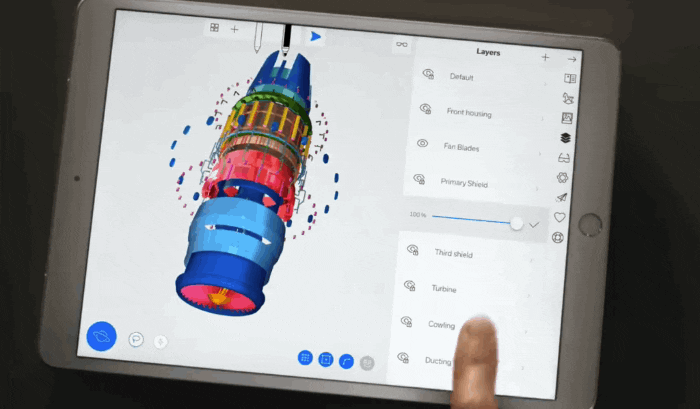
uMake on the iPad, featured on Apple's website
The AR and VR era — The Renaissance of 3D Design Software
Mobile helped a lot in shaping the user interfaces of today’s software, making it easier to distribute and to consume. How are we going to move forward with 3D design software?
It seems that big companies like Google, Facebook, Microsoft, and Apple are not waiting for anyone, and have already started the race for 3D content by working on their 3D creation tools. Let’s take a look at the current efforts:
Apple
Until June 2017, Apple only talked about the potential of AR, but now it not only shows its power but is opening its platform to the massive iOS developer’s community. In the next few months, we should see more and more AR apps or AR-ready apps that will change the way we consume and create a design.
Apple didn’t present a 3D creation tool, yet. Though, based on its latest releases, like Clips, and its iTunes productions, like ‘Planet of Apps,’ it’s a matter of time until Apple will introduce to its users a way to create in 3D or consume digital 3D content.
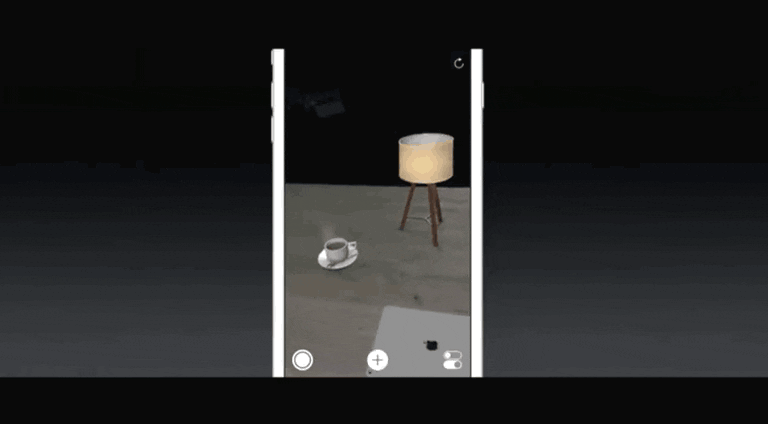
First ARKit Demonstration from Apple's Keynote 2017
The first footprint in 3D for Google was back in 2006 with the acquisition of SketchUp. Back then, Google wanted to enrich its Maps with 3D buildings, and SketchUp was perfect for that job. Since then, Google was highly involved in the 3D design space with the acquisition of ‘TiltBrush’, a 3D sketching app for VR, and unique experiences tailored to its hardware, like the mobile VR headset ‘Daydream’. Recently, Google launched a new 3D design tool for VR named ‘Blocks’ to allow more people to create 3D (low-poly) content.
Google’s goal is to allow people to create ‘stuff’ so they can enrich their future VR or AR environment.

Google Blocks
While being pretty new to the 3D design space, Facebook already holds many achievements in the form of launching its own VR hardware, Oculus; a consumer-facing ‘AR Studio’; Quill and Medium — Two VR 3D design tools; and introduced this year a new AR platform for developers with advanced AR technology.
Facebook anticipates that AR will have a similar effect on 3D design space like the one the iPhone and Instagram had on photography and Photoshop. That’s why it’s creating a platform where people would be able to create and consume 3D content with ease, as it did in the past with camera masks, stickers, and more.
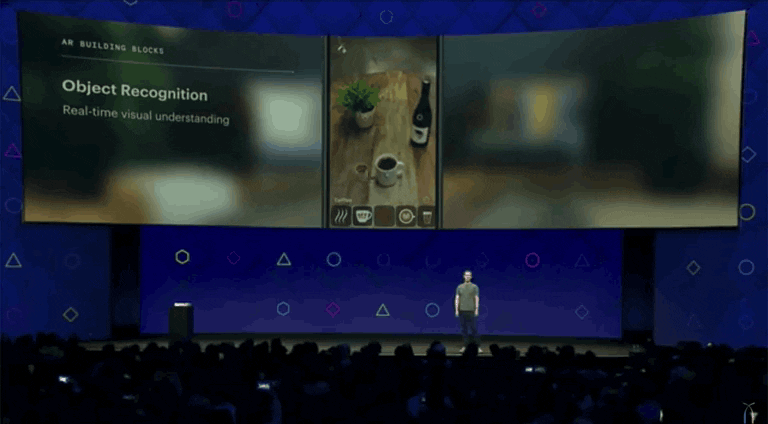
Facebook F8 - Mark Zukerberg's demo of Advanced Camaera AR features
Microsoft
Microsoft was one of the firsts to recognize the potential of AR with its hardware — ‘HoloLens.’ Microsoft introduced HoloLens at the beginning of 2015 and showed its vision for the future of AR.
In Microsoft’s vision, anyone can open their studio, build anything in 3D and even print it out in 3D. HoloLens as hardware is very impressive, although a bit limited in what you can do right now. That said, a vision where we wear glasses and operates with our hand to create and design is something we all looking forward to seeing and experiencing.
Along with its efforts in AR, Microsoft has also released Microsoft Paint 3D — a modern version of its legacy MS Paint, to allow more people to engage with 3D design and democratizing it.

Microsoft HoloLens Studio
Who Wins? The Consumer
The commercial 3D design space didn’t see a mass of innovation like the ones that have happened in the past 3 years, in its 40 years of existence. The fact that major companies like Apple, Google, Facebook, and Microsoft are working hard on technologies that, until recently were considered to be sci-fi, is fascinating, inspiring and motivating for the whole industry.
The combination of great innovation, advanced technologies, and the financial investments coming from major companies will create a competitive landscape that will push for better 3D creation experiences and better 3D content.
The end-user is the one that takes it all — a future where people are more creative, filling their lives and surroundings with their creations, is the world where we all would love to live in.








